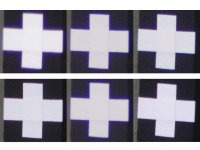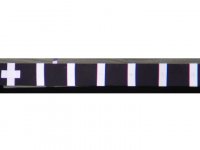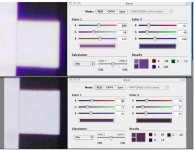henry link
Well-known member
Recently there were some complaints on another thread that we‘re not being informed about what kind of “ED” glass is actually used in various new binoculars that claim to use a special low dispersion glass. That’s true and the manufacturers are not likely to reveal the exact ED glass type they use, but knowing that wouldn’t really tell us what we want to know anyway. What’s important is not the glass type, but whether the overall design actually accomplishes the goal of reducing longitudinal CA compared to a conventional design. We can see that for ourselves.
The photos below show the center of a CA target I use to evaluate both longitudinal and transverse CA. They were made by simply placing the camera behind the binocular eyepiece, then cropping down to a tiny area of the center of the field. This is similar to what you would see with the magnification of these 8x binoculars boosted to about 64x.
The top row shows the CA at the center of the field for three binoculars: left-CZJ 8x50 Octarem, center-Nikon 8x32 SE and right-Zeiss 8x42 FL. The purple fringe (red+blue) radiating in all directions is longitudinal CA. It’s quite obvious in the conventional Octarem and SE and slight in the FL. So, whatever glass is used in the FL does reduce longitudinal CA.
Most of the color fringe visible in the FL is transverse CA (lateral color) rather than longitudinal. Notice that the color is reddish in one direction, but bluish in the opposite direction. This form of CA appears in the photo either because the target is a little off center or the (hand held) camera is not quite in line with the eyepiece. The same kind of misalignment between eyepiece and eye is constantly occurring when binoculars are used hand held. The FL actually has a bit more transverse CA than the Octarem or the SE. The amount at the very center of the field is tiny, but it starts to become visible even at normal magnification only about 4-6 degrees off axis and becomes quite obvious closer to the edge of the field. Other expensive roof prism binoculars with complex objectives have considerably more transverse CA than the FL and all binoculars show more visible transverse CA than longitudinal. It’s the color fringing seen when dark birds are perched on a wire in front of a bright sky.
The bottom row shows the same three binoculars, but with the Octarem and the FL stopped down to the same 32mm aperture as the SE to simulate the stop down imposed by the eye in daylight. Now the Octarem is nearly as free of longitudinal CA as the FL. That’s because it’s stopped down from about f/4 to about f/6.7 (higher focal ratio = lower CA). The SE stays at f/4 so there is no improvement. The FL changes to about f/5 with slight improvement over CA that was already pretty well corrected. From this you can see that, for daylight uses, large exit pupil binoculars like 7x42, 7x50, 8x50 and 8x56 have always had low longitudinal CA, quite comparable to modern “ED” binoculars.
The photos below show the center of a CA target I use to evaluate both longitudinal and transverse CA. They were made by simply placing the camera behind the binocular eyepiece, then cropping down to a tiny area of the center of the field. This is similar to what you would see with the magnification of these 8x binoculars boosted to about 64x.
The top row shows the CA at the center of the field for three binoculars: left-CZJ 8x50 Octarem, center-Nikon 8x32 SE and right-Zeiss 8x42 FL. The purple fringe (red+blue) radiating in all directions is longitudinal CA. It’s quite obvious in the conventional Octarem and SE and slight in the FL. So, whatever glass is used in the FL does reduce longitudinal CA.
Most of the color fringe visible in the FL is transverse CA (lateral color) rather than longitudinal. Notice that the color is reddish in one direction, but bluish in the opposite direction. This form of CA appears in the photo either because the target is a little off center or the (hand held) camera is not quite in line with the eyepiece. The same kind of misalignment between eyepiece and eye is constantly occurring when binoculars are used hand held. The FL actually has a bit more transverse CA than the Octarem or the SE. The amount at the very center of the field is tiny, but it starts to become visible even at normal magnification only about 4-6 degrees off axis and becomes quite obvious closer to the edge of the field. Other expensive roof prism binoculars with complex objectives have considerably more transverse CA than the FL and all binoculars show more visible transverse CA than longitudinal. It’s the color fringing seen when dark birds are perched on a wire in front of a bright sky.
The bottom row shows the same three binoculars, but with the Octarem and the FL stopped down to the same 32mm aperture as the SE to simulate the stop down imposed by the eye in daylight. Now the Octarem is nearly as free of longitudinal CA as the FL. That’s because it’s stopped down from about f/4 to about f/6.7 (higher focal ratio = lower CA). The SE stays at f/4 so there is no improvement. The FL changes to about f/5 with slight improvement over CA that was already pretty well corrected. From this you can see that, for daylight uses, large exit pupil binoculars like 7x42, 7x50, 8x50 and 8x56 have always had low longitudinal CA, quite comparable to modern “ED” binoculars.
Attachments
Last edited:







